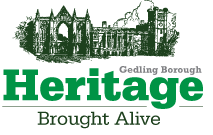Churches & Religion
In the 12th & 13th centuries Newstead Priory was developed by Augustinian priors. It was closed during the Reformation in 1539, with the land and buildings sold to Sir John Byron, of Colwick Hall the following year. He converted the priory into a grand residence, which was passed down through his family, and became known as Newstead Abbey. The estate, sold by the poet Lord Byron to the Wildman family, was occupied as a house until the 1930s, since when it has been owned by Nottingham City Council. The West Front of Newstead Abbey is the most extensive part remaining of the religious buildings. There is a chapel which is still used for services.
Long after the Reformation in the 16th century, the only places of worship were the parish churches of the Church of England. In the 18th century, however, several non-conformist groups outside the “established” church were founded. In what is now the Gedling borough area, the strongest of these were the Methodist Societies, although several Baptist chapels were also built. These non-conformist religions appealed to working people because they were more democratic. Initially, congregations met in private houses but eventually chapels were built in most villages, though few have survived in their original condition.
A survey in 1829 listed five non-conformist chapels in Arnold, one in Burton Joyce, four in Calverton, two in Carlton, one in Lambley, one in Papplewick, one in Stoke Bardolph and one in Woodborough. The chapels in several of the villages were rebuilt in the 19th century. Woodborough and Calverton both have Baptist chapels dating from 1832; the Methodist chapel in Lambley dates from 1849, though it is now occupied as a house, and Woodborough chapel was rebuilt in 1887. A small brick chapel for the United Methodist Free Church was built on Carlton Hill in 1888. The building is still used as a Christian meeting place.
An unusual character: John Roe founded a religious sect known as ‘Roeites’ or Reformed Quakers in Calverton in the 18th century and members of the sect were baptised in the pond in his garden. John Roe is also remembered for developing a fine species of plum tree, grown locally to this day.
To find out more about historic churches in the borough click here:
http://southwellchurches.nottingham.ac.uk/_main/hindex.php



